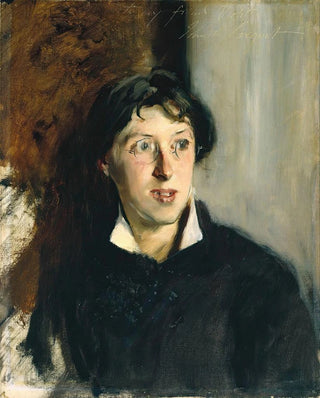Art print | Portrait of Vernon Lee 1856-1935 - John Singer Sargent


View from behind

Frame (optional)
The "Portrait of Vernon Lee" created by John Singer Sargent between 1881 and 1882 is a work that embodies the very essence of the modern portrait. This painting does not merely capture the physical appearance of its subject but ventures to explore the psychological depth of the personality it depicts. Vernon Lee, whose real name was Violet Paget, was an influential writer and intellectual of her time, renowned for her work on aesthetics and literary criticism. Sargent, with his unparalleled talent for portrait painting, manages to reveal the sharp mind and complexity of this fascinating woman, making this masterpiece an essential piece in art history.
Style and uniqueness of the work
In this piece, Sargent employs a rich and subtle palette, skillfully playing with light and shadow to bring his subject to life. The texture of Vernon Lee’s clothing, as well as the details of her face, are rendered with remarkable precision, demonstrating the artist’s technical mastery. Vernon Lee’s gaze, both thoughtful and penetrating, seems to invite the viewer to delve into her inner thoughts. The background, blurred and indistinct, highlights the figure of the woman, emphasizing her importance and presence. This stylistic choice illustrates Sargent’s ability to transcend the simple portrait to offer a true character study, where each brushstroke contributes to a rich and engaging visual narrative.
The artist and his influence
John Singer Sargent is often celebrated as one of the greatest portraitists of his era, and his work has left an indelible mark on the art world. Trained at the École des Beaux-Arts in Paris, he mastered blending European influences with American traditions, creating a unique style that captivated the elites of his time. Sargent painted many notable figures, ranging from aristocrats to artists, and his bold approach to portraiture paved the way for new ways of representing individuals. His influence endures today, inspiring not only contemporary artists but also art enthusiasts seeking to understand the nuances of representation.

Matte finish

View from behind

Frame (optional)
The "Portrait of Vernon Lee" created by John Singer Sargent between 1881 and 1882 is a work that embodies the very essence of the modern portrait. This painting does not merely capture the physical appearance of its subject but ventures to explore the psychological depth of the personality it depicts. Vernon Lee, whose real name was Violet Paget, was an influential writer and intellectual of her time, renowned for her work on aesthetics and literary criticism. Sargent, with his unparalleled talent for portrait painting, manages to reveal the sharp mind and complexity of this fascinating woman, making this masterpiece an essential piece in art history.
Style and uniqueness of the work
In this piece, Sargent employs a rich and subtle palette, skillfully playing with light and shadow to bring his subject to life. The texture of Vernon Lee’s clothing, as well as the details of her face, are rendered with remarkable precision, demonstrating the artist’s technical mastery. Vernon Lee’s gaze, both thoughtful and penetrating, seems to invite the viewer to delve into her inner thoughts. The background, blurred and indistinct, highlights the figure of the woman, emphasizing her importance and presence. This stylistic choice illustrates Sargent’s ability to transcend the simple portrait to offer a true character study, where each brushstroke contributes to a rich and engaging visual narrative.
The artist and his influence
John Singer Sargent is often celebrated as one of the greatest portraitists of his era, and his work has left an indelible mark on the art world. Trained at the École des Beaux-Arts in Paris, he mastered blending European influences with American traditions, creating a unique style that captivated the elites of his time. Sargent painted many notable figures, ranging from aristocrats to artists, and his bold approach to portraiture paved the way for new ways of representing individuals. His influence endures today, inspiring not only contemporary artists but also art enthusiasts seeking to understand the nuances of representation.






